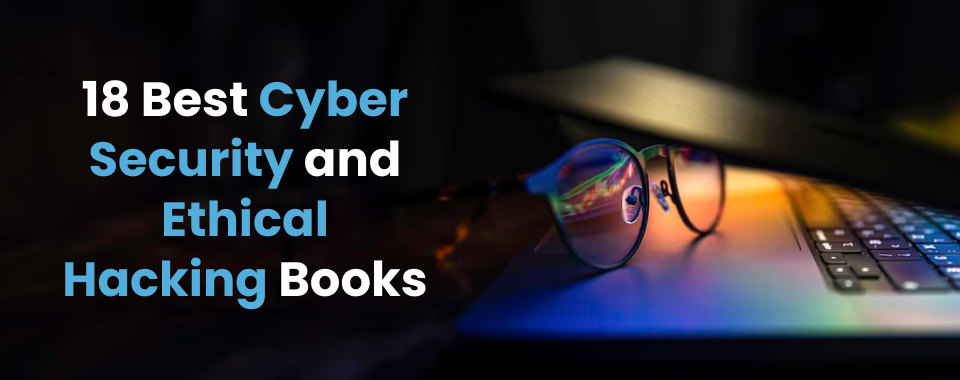
jump-hereToday, the study of cybersecurity is booming at an unprecedented rate. This is breaking open doors for numerous new job opportunities in cybersecurity. If you wish to learn cybersecurity, a few books will make your learning process worthwhile. This article on ethical hacking + cybersecurity books will guide you through the top cybersecurity books. These books will get you introduced to new concepts and assist in resolving your cybersecurity issues.
What is Cybersecurity?
Before we jump into the top cybersecurity books, let’s quickly refresh your memory about cybersecurity. Cybersecurity means safeguarding programs, networks, computer systems and their parts from unauthorized digital input and attack, what we term as cyberattacks.
Cyberattacks lead to organizations losing confidential information and acces`s, money and reputation. It is therefore imperative to prevent cyberattacks and deploy cybersecurity.
What is Ethical Hacking?
Ethical hacking is the identification and exploitation of a system’s vulnerability. We do this in order to secure the system.
We have people who carry out ethical hacking as ethical hackers. Ethical hackers do this only after seeking permission from the relevant authorities. Different hacking tools and methods are employed to execute ethical hacking.
Let us now introduce you to the list of the top cybersecurity books.
Become a Certified Ethical Hacker!
CEH v13 – Certified Ethical Hacking CourseExplore ProgramBecome a Certified Ethical Hacker!
The Cybersecurity Books
We have designed a list of the top cybersecurity and ethical hacking books to assist learners. Let’s begin:
1. Hacking: A Beginners’ Guide to Computer Hacking, Basic Security And Penetration Testing
Author: John Slavio
The hacking book is useful for beginners. It can assist you in making your first step in an ethical hacking career.
This book encompasses the history of hacking, hacker types, different hacking attacks, key hacking tools and software, and IP address hiding.
It also touches on mobile hacking, hacking of email addresses, penetration testing and spoofing attacks.
2. Hacking: The Art Of Exploitation
Author: Jon Erickson
This globally renowned hacking book is available in two editions, one published in 2003 and the other in 2008.
It specializes in network security and computer security. The second edition of the book makes you familiar with C programming from the point of view of a hacker. Here you will be able to program computers in C as well as in shell scripts.
Amongst many concepts of the book, you will also be taught to hijack TCP connections, Crack wireless traffic that is encrypted, and make brute-force attacks faster.
3. Metasploit: The Penetration Tester’s Guide
Authors: David Kennedy, Jim O’Gorman, Devon Kearns, and Mati Aharoni
A Metasploit framework is an important utility that hackers employ to find and use vulnerabilities. But for beginners, it is a bit complicated. So, this book will educate you on everything there is to know about Metasploit.
Through this book, you will learn the framework’s interfaces, module system, and advanced penetration testing methods, including network reconnaissance, client-side attacks, wireless attacks, and focused social-engineering attacks.
There, you will learn how to Integrate NeXpose, Nmap and Nessus into Metasploit to automate the discovery.
In this ethical hacking book, you will learn plenty of hacking tricks.
4. Penetration Testing: A Hands-On Introduction to Hacking
Author: Georgia Weidman
This cyber security handbook gives you an idea of penetration testing, which is finding security vulnerabilities in operating systems, networks, and applications.
This handbook emphasizes the fundamental skills and processes that a penetration tester needs. It will introduce you to the key phases of an actual test, including information gathering, deciphering vulnerabilities, gaining network access, etc.
Apart from the above, you will learn to crack passwords, evade antivirus tools, automate attacks, and exploit using the Metasploit framework and create your Metasploit modules.
5. The Hacker Playbook 3: Practical Guide To Penetration Testing
Author: Peter Kim
This is the third edition of the THP—The Hacker Playbook Series. It covers new strategies, attacks, exploits, and tips and emphasizes a few techniques from the earlier versions.
The Hacker Playbook 3 – Red Team Edition introduces you to the Red Team. Red Teams mimic real-world, sophisticated attacks to probe your organization’s defense teams.
This will aid in helping you further your offensive hacking techniques and attack vectors. It also centers around real-world attacks, exploitation, custom malware, persistence, and more.
Did You Know?
In Q2 2024, organizations had an average of 1,636 cyber attacks each week, a 30% increase year-over-year.
6. Practical Malware Analysis: The Hands-On Guide to Dissecting Malicious Software
Authors: Michael Sikorski, Andrew Honig
Malware is harmful software that hackers use to take advantage of system weaknesses. Practical Malware Analysis is a book that trains readers on tools and methods employed by cyber security experts.
This book will lead you to dissect, debug, and disassemble malware.
Here, you will also learn how to create a secure virtual lab to analyze malware, how to crack malware, measure the damage it has caused, sanitize your network and ensure that the malware never returns.
7. Social Engineering: The Science of Human Hacking
Author: Christopher Hadnagy
Social engineering relies on human mistakes in order to access sensitive information. Systems could be secured, yet we can’t employ code that’s guaranteed to assist in securing information when it is a human entity.
This book illustrates the most prevalent social engineering techniques and demonstrates how they were employed in the past.
Here, you will learn to study typical social engineering tricks, how social engineers can exploit emotions, take effective countermeasures against hacking and more.
8. Applied Cryptography: Protocols, Algorithms and Source Code in C
Authors: Bruce Schneier
This cyber security book offers a complete survey of cryptography today. It explains how experts can utilize cryptography to encipher as well as decipher messages. It includes a number of cryptography algorithms and demonstrates how to address security issues.
9. Black Hat Python: Python Programming for Hackers and Pentesters
Author: Justin Seitz
Most exploit frameworks are in the language Python; in this case, using GitHub, you will get to build a trojan command-and-control, identify sandboxing, and automate usual malware operations.
Here, you will learn the darker aspects of Python’s potential, including infecting virtual machines, crafting network sniffers, and building stealthy trojans.
This book includes networking basics, web applications, windows privilege escalation tricks and more.
10. The Web Application Hacker’s Handbook: Finding and Exploiting Security Flaws
Author: Dafydd Stuttard and Marcus Pinto
This book’s second edition centers on contemporary Web applications, to which it makes them vulnerable and allows for fraudulent transactions.
It talks about the new step-by-step techniques for attacking and defending the wide variety of constantly changing Web applications. It also talks about new remoting frameworks, HTML5, UI redress and hybrid file attacks, just to mention a few.
Apart from the above, the other topics are Attacking Authentication, Attacking the Application Server and Finding Vulnerabilities in Source Code.
11. Hacking: Computer Hacking, Security Testing, Penetration Testing, and Basic Security
Author: John Slavio
Hacking could be a serious threat to anyone. The only way to save yourself from hacking is to learn hacking. All the fundamentals of hacking and the advanced techniques and steps that you could employ for hacking are included in this book. It provides simple technical language that even beginners could grasp without omitting any complicated details necessary for hacking.
The language in this ethical hacking book is simple enough for novice hackers to follow but does not skip any of the complex information needed to undertake computer hacking.
12. Computer Hacking Beginners Guide
Author: Alan T. Norman
This book is ideal for beginners to learn how to create their first hack. The book has all the various methods and tools that are employed by both criminal and ethical hackers. You will discover how information security can be broken and how attacks can be identified in any system. You will also discover techniques of spoofing, WiFi hacking, and email hacking, in addition to many tips on ethical hacking.
13. Hackers & Painters: Big Ideas From The Computer Age
Author: Paul Graham
With thoughtful language and historical analogies, Graham leads readers through an adventure referred to as “an intellectual Wild West,” in which he describes the world of technology and what drives the inhabitants of it. You will discover hackers, what drives them to hack, and why you should be interested. There are so many other concepts that are covered in this boo,k such as the role of beauty in software design, becoming rich, free speech, the open-source revolution, internet start-ups, the renaissance of programming languages, digital design, and much more.
14. Advanced Penetration Testing: Hacking the World’s Most Secure Networks
Author: Wil Allsopp
This book is authored by Wil Allsopp, who is one of the world’s leading security experts to have done hacking and penetration testing for Fortune 100 companies. The book has numerous sophisticated hacking methods for high-security environments. The book also gives an elaborate and very realistic attack simulation with examples using Kali Linux and Metasploit. You will also learn how to penetrate deep into operating systems and networks using harvested credentials.
The Hardware Hacker: Adventures in Making and Breaking Hardware
Author: Andrew Bunnie Huang
The Hardware Hacker is an essential read for all potential hackers. It has a series of personal accounts and interviews discussing issues like the legality of reverse engineering, law, intellectual property behavior between China and the United States, and so on. It also has extremely detailed sections on manufacturing and offers a thorough perspective on the problems involved with open-source hardware.
BackTrack 5 Wireless Penetration Testing Beginner’s Guide
Author: Vivek Ramachandran
This book is designed to be readable by beginners so that they can learn the principles and methods of wireless attacks in an easy-to-understand manner. All attacks are explained through vivid descriptions and steps in the context of a lab exercise. This book presumes some level of Backtrack and wireless familiarity. So, if you are an IT person or a security consultant with a little experience in Backtrack, then this book is for you.
17. Gray Hat Hacking: The Ethical Hacker’s Handbook
Authors: Allen Harper, Ryan Linn, Stephen Sims, Michael Baucom, Huascar Tejeda, Daniel Fernandez, Moses Frost
This book offers step-by-step directions on how to strengthen computer networks through effective ethical hacking methods. It contains actionable planning and analysis techniques for finding a hacker’s sly tools, abilities, and strategies and fighting them with field-proven solutions, testing labs, and case studies. You will receive thorough coverage of malware analysis, penetration testing, and reverse engineering methods.
18. Hacking Made Easy (The Art of Information Gathering & Scanning)
Author: Harsh Bothra
This book gives a straightforward method of hacking for technical and non-technical readers. You will gain knowledge about the current tools and methods of the new Penetration Testing Framework, find vulnerabilities, fix vulnerabilities, and guard assets on the network. The book also contains detailed, real-world examples of several hacking methods and serves as a guide for your tangible step in information security.
Those were the top cybersecurity books.
For more insights visit alpheric








